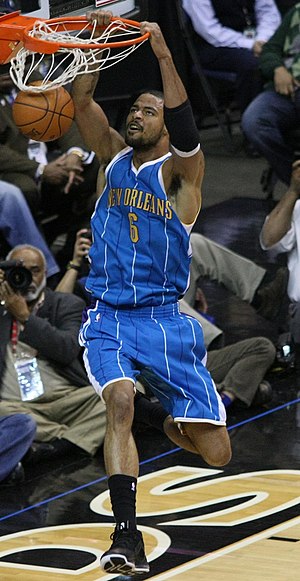 Image via WikipediaLike so many teams (outside of the Heat) who entered the summer of 2010, the Mavericks had ambitious hopes for how they would use the non-guaranteed contract of Erick Dampier. I'm sure Tyson Chandler wasn't amongst their top-10 choices for how to use the trade chip, but he undoubtedly becomes another strong piece on an already deep team.
Image via WikipediaLike so many teams (outside of the Heat) who entered the summer of 2010, the Mavericks had ambitious hopes for how they would use the non-guaranteed contract of Erick Dampier. I'm sure Tyson Chandler wasn't amongst their top-10 choices for how to use the trade chip, but he undoubtedly becomes another strong piece on an already deep team.The Mavericks also approached an advanced stage of trade discussions with the Wolves on Al Jefferson, but David Kahn received two first round picks from Utah and he did not have to take back any bad contracts that Dallas had hoped for. So Chandler became the less costly alternative for the Mavericks since they unloaded Eduardo Najera and Matt Carroll in the process, while also acquiring young project center Alexis Ajinca.
The fundamental problem with the Dallas strategy of using the Dampier non-guaranteed contract (EDNGC for short) was the somewhat unforeseen flood of traded player exceptions to hit the market. We knew there was a good chance that Toronto would acquire one by doing a sign-and-trade involving Chris Bosh, but we expected Cleveland to stubbornly decline participation involving LeBron James. The Jazz and Suns also received TPEs from the Bulls and Knicks for Carlos Boozer and Amar'e Stoudemire.
Leaving that as an aside, what are the Mavericks gaining in Chandler?
Chandler is approaching 28 and has become increasingly fragile physically in his late 20s. He also has been traded twice without actually being all the way traded. First, he was dealt to Oklahoma City in February of 2009, only to have it rescinded after a physical. More recently, he was told by the Bobcats that he would be dealt to Toronto, only to have Michael Jordan kill it at the last minute.
Chandler's PER dropped from his career highs of 17.0 and 17.5 in 06-07 and 07-08 down to 13.4 and 12.5 in each of the past two seasons. The most recent PER was especially problematic since his minutes per game dropped to 22.8 and efficiency should generally rise when playing fewer minutes.
The major reason for the decline has been his rapid and substantial drop on the glass. Chandler's rebound percentage was 20.7% and 19.5% during the successful two-year run and just 16.4% and 16.6% in each of the past two seasons. He has been banged up and rebounding is where we do begin to see the early stages of physical decline, or injury.
Chander did, however, have a career high in TS% at 64.3%, but his eFG% remained far lower than the 62.4%/62.3% of a couple years ago. The TS% increase was due to his sudden elevation of his free throw shooting.
While with the Bobcats, the vast majority of his offense came on the offensive glass and on cuts. Chandler has always been efficient with put backs, but his offensive rebound rate will need to get back to where it was originally in New Orleans to make a real impact for the Mavericks. He was once a dangerous pick-and-roll threat, but that hasn't returned since his injury and he was never very good in the post to begin with.
Defensively, he has suffered some slippage as well, but he'll still block his shots here and there. His block rate in 09-10 was less than some of his peaks, but it was his highest rate since 06-07. He is not the best post defender and struggles against his own man in the pick-and-roll, but at the very least he's a long body that can stand eye-to-eye against Gasol and Andrew Bynum.
Grade for Mavericks: B
The Bobcats were appearing likely to trade Chandler and Boris Diaw to the Raptors for Jose Calderon and Reggie Evans, but again went with this trade of pure spare parts. Charlotte receives some savings in the first year, but they weren't over the luxury tax, so it is difficult to understand the impetus.
Grade for Bobcats: C+
http://mavericks.realgm.com/articles/73/20100715/grading_the_deal_mavericks_use_edngc_for_chandler/

No comments:
Post a Comment